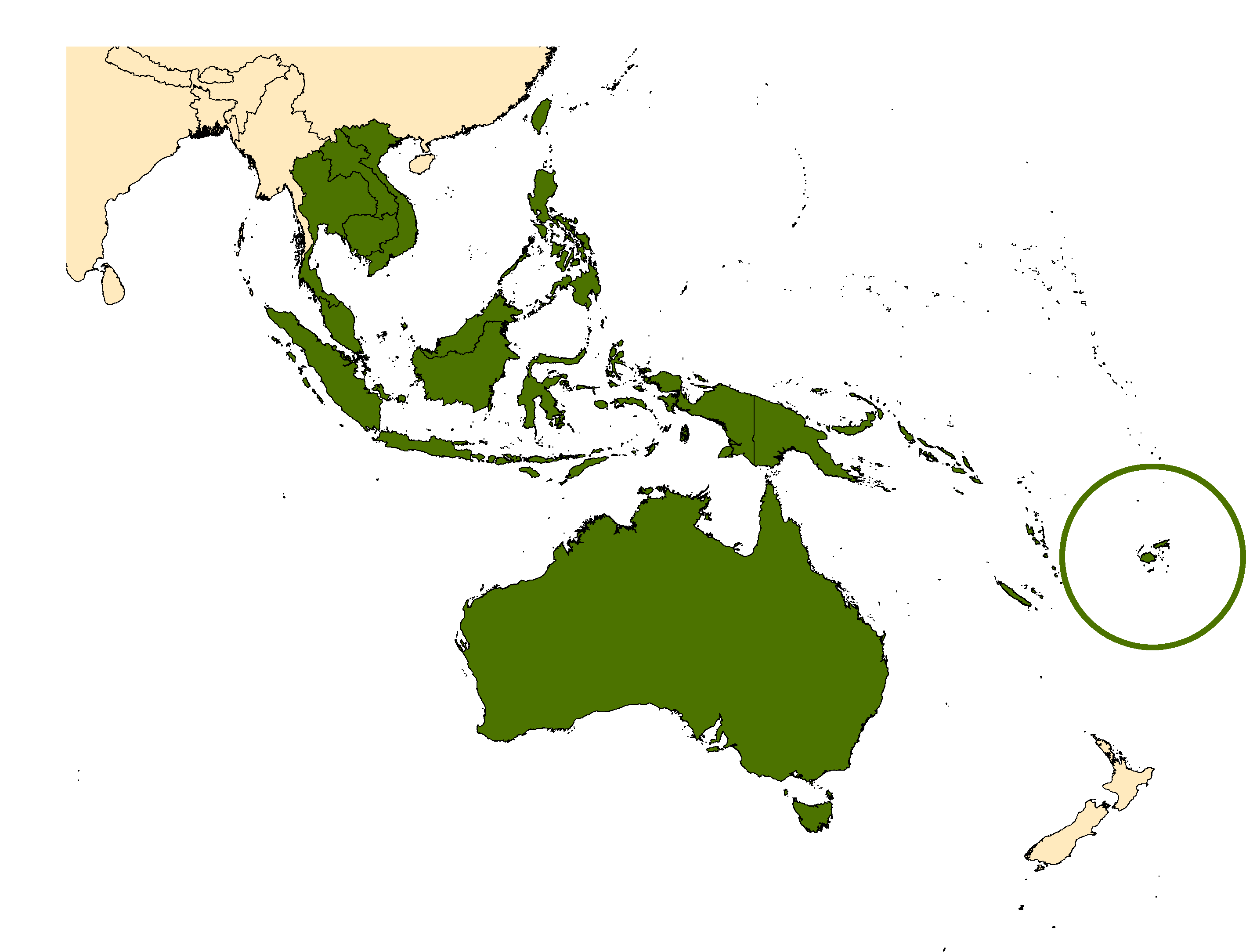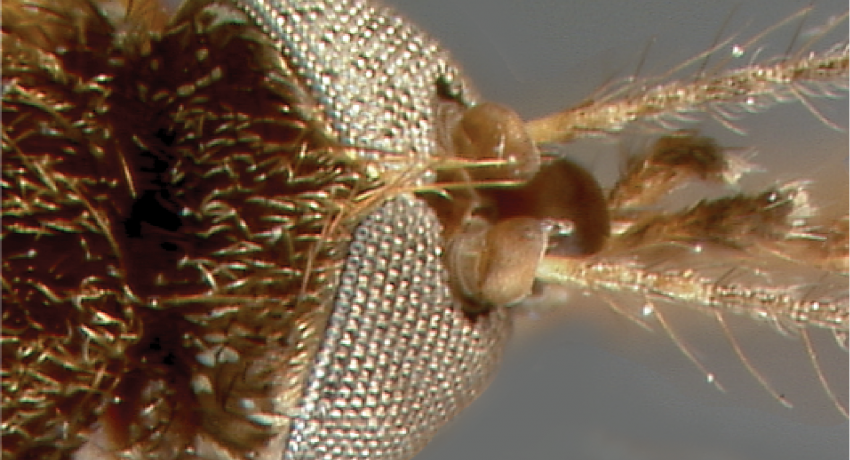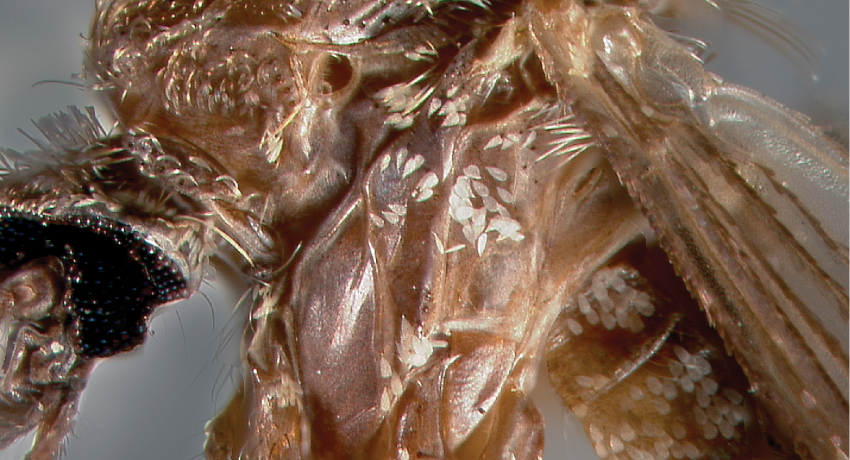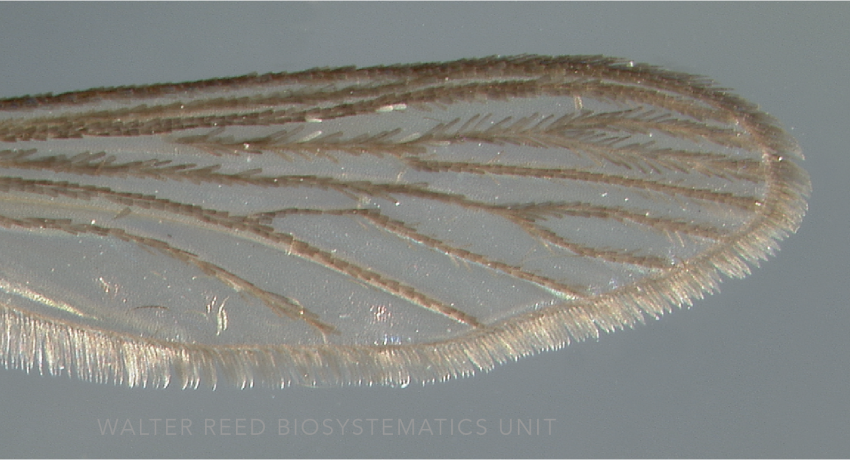AUSTRALASIAN & ORIENTAL REGIONS
Etymology: not stated [vigilant, watchful (L)]
Aedes vigilax is common in salt marshes and mangrove swamps across the Australasian region. Its overall drab salt and pepper coloration is sharply contrasted by the broad white stripes donning its abdomen and tarsi. The species has two synonyms—marinus Theobald and annulifera Ludlow—and two valid subspecies: Ae. vigilax ludlowae (Blanchard) from the Philippines, Thailand and Taiwan, and Ae. vigilax vansomerenae Mattingly from the Seychelles. Aedes vigilax ludlowae also has two synonyms—pseudovigilax Theobald and uniformis Strickland. Aedes vigilax and its two subspecies comprise the informal Empihals Group of the subgenus Ochlerotatus.
Type locality: Gosford, Kiama & National Park, New South Wales & Brisbane, Queensland, Australia
Type depository: Macleay Museum of Natural History, University of Sydney, Sydney, Australia (MM)
DIAGNOSTIC CHARACTERS (Click photos to view; mouse over and click large photo to zoom in.)
ADULT (illustrated) Head: Basal 0.67 of proboscis with midventral pale scaling; decumbent scales of vertex mostly narrow; erect scales of head cover most of dorsal surface. Thorax: Antepronotum with scales; proepisternum with scales; subspiracular area without scales; postspiracular patch of broad whitish scales; paratergite with scales; prealar area with patch of broad white scales; lower mesepimeral setae absent; scutum without distinctive markings; scutum just anterior to scutellum with anterior pale scale patch entirely white, sometimes with pale brown scales along acrostichal line. Legs: Ta-III with basal pale bands ≥0.25 length of tarsomeres; terga with white basal bands of uniform width; Ta-I–III with distinct white basal bands. Wing: With small areas of white scaling.
LARVA (not illustrated) Head: Seta 4-C short, nearer level of 6-C than 5-C; setae 11,12-C short. Thorax: Seta 5-P single or double; lateral spine of plate bearing setae 9–12-M,T small and lightly pigmented. Abdominal segments: Most abdominal setae comparatively short; seta 1-III–V short, branched; seta 6-III branched. Terminal segments: Comb scales in 1–3 irregular rows; saddle incomplete; anal papillae shorter than 0.5 x length of saddle; seta 3-X single; siphon index <2.0; pecten spines comprising pecten evenly spaced, none widely spaced beyond seta 1-S.
TAXONOMIC KEYS
Lee et al. 1984
Rattanarithikul et al. 2010
Becker et al. 2010
![]()
WRBU – Aedes – Australasian Region – Larva
![]()
WRBU – Aedes – Indomalayan Region – Adult
![]()
WRBU – Aedes – Indomalayan Region – Larva
![]()
WRBU – Aedes – Oriental Region – Adult
![]()
WRBU – Aedes – Oriental Region – Larva
Exemplar DNA sequences
Ae. vigilax COI: GQ143720–32, MG242526
BIONOMICS
Immatures
The eggs of the salt marsh floodwater species Ae. vigilax appear more sensitive to dessication than other Aedes, and careful oviposition choices appear to be a key survival strategy. Female Ae. vigilax seek out marine couch plants (Sporobolus spp.) and their sods, attaching the eggs up to 4cm from the ground, perhaps using exochorionic exudates and the rough texture of the cigar-shaped egg to minimize egg detachment from these humid spots. After innundation, the eggs undergo installment hatching, and newly-hatched larvae start to disperse across the marshes 1–2 hours later. First and second instar larvae actively move to the lower terrain, where water is most likely to gather in brackish water ground pools large enough to facilitate their successful ecolsion.
Adults
Aedes vigilax fly considerable distances from the saltmarshes to find suitable hosts. Females are aggressive biters and will bite any time of the day or night, with peak biting around sunset. Documented hosts of Ae. vigilax include people, dogs, birds, brushtail possums, cats and flying foxes. Asa result of its opportunistic feeding habits, Ae. vigilax is involved in the transmission of a number of arboviruses, and is the principal vector of non-periodic filariasis in New Caledonia and the Loyalty Islands.
DISTRIBUTION NOTES
Australia, Fiji, Indonesia (Java, Flores, Kalimantan, Sulawesi, Sumatra includes Ketulauan Riouw Archipelago, Timor), Malaysia, New Caledonia, Papua New Guinea, New Hebrides, Philippines, Seychelles, Solomon Islands, Taiwan, Thailand, Timor, Tonga, Vanuatu, Vietnam.

WRBU VECTOR HAZARD REPORTS
None; View other WRBU Vector Hazard Reports
Available GIS Models
Ae_vigilax_Dornak_1 Australasia
IMPORTANT REFERENCES (full citations below)
Skuse 1889: 1731 (F; as Culex)
Bancroft 1908: 41 (M, F; "Black Bush-Mosquito")
Edwards 1924b: 375 (F; as albirostris)
Mackerras 1927: 296 (M*)
Borel 1930: 280 (M*, F, L*)
Hamlyn-Harris 1933: 229 (F*; bionomics)
Taylor 1943b: 74 (M, F, L*)
Lee 1944a: 53 (L*)
Penn 1949b: 42 (P*)
Klein & Marks 1960: 112 (F*; as albirostris; synonym)
Klein & Marks 1960: 115 (synonym)
Mattingly 1961: 39 (M*, F*, P*, L*)
Belkin 1962 (M*, F, P*, L*; taxonomy, bionomics, distribution)
Dobrotworsky 1965: 79 (M*, F*, L*)
Mohrig 1967 (F*)
Marks 1969b: 81 (taxonomy; as albirostris)
Basio 1971b: 25 (M*; bionomics)
Tanaka et al. 1975c: 220 (distribution)
Tanaka et al. 1979: 262 (L*)
Lee et al. 1984: 207 (F key, taxonomy, bionomics, distribution, review)
Kay & Jorgensen 1986 (E*)
Linley et al. 1992a (E*)
Whelan & Hapgood 2000 (bionomics, distribution; East Timor)
Rattanarithikul et al. 2010 (F*, L*; keys, bionomics, distribution; Thailand)
Becker et al. 2010: 364 (F*, L*; key, taxonomy, distribution, bionomics)
Puslednik et al. 2012 (distribution, bionomics, molecular taxonomy)
CURRENT SYNONYMS
syn. marinus Theobald
1901a: 396 (M*, F*; Culex). Type locality: Queensland, Australia (NHMUK).
syn. annulifera Ludlow
1903: 141 (F; Culex). Type locality: Mangarin, Mindoro, Philippines (USNM). References: Stone & Knight 1956a: 214 (type information).
ssp. ludlowae (Blanchard)
1905: 630 (as Culex ludlowii; new name for annulifera Ludlow, not Blanchard 1852). Distribution: Philippines. References: Knight & Hull 1951b: 226 (M*, F, L*; to ssp.; type information, lectotype designation); Laffoon & Knight 1971 (F*); Baisas 1974: 25 (M*, F, P*, L*; taxonomy, bionomics, distribution; Philippines); Harbach & Knight 1980 (F*). Etymology: Clara Southmayd Ludlow. Informal name: Ludlow Philippine Pointy Mosquito.
syn. pseudovigilax Theobald
1907: 382 (M*, F*; Culicelsa). Type locality: Burpengary, Queensland, Australia (NHMUK).
syn. uniformis Strickland
1911a: 131 (F; Culicelsa). Type locality: Kings Park, Perth, Western Australia, Australia (NHMUK). References: Belkin 1962: 393 (lectotype).
ssp. vansomerenae Mattingly
1955: 78 (M*, F*, P*, L*; as Aedes) in Mattingly & Brown 1955. Type locality: Anse Lascar, Silhouette Island, Seychelles (NHMUK). Distribution: Seychelles. References: Le Goff et al. 2012 (F key; bion.; distr.; Seychelles). Etymology: Ellinor Catharine Cunningham-van Someren. Informal name: Someren Seychellois Pointy Mosquito.
CITED REFERENCES
Bancroft, T. L. (1908). List of the mosquitoes of Queensland, with the original descriptions and notes on the life-history of a number. Annals of the Queensland Museum, 8, 1–64.
Basio, R. G. (1971b). The mosquito fauna of the Philippines (Diptera, Culicidae). Manila: National Museum of the Philippines. 198pp.
Becker, N., Petrić, D., Zgomba, M., Boase, C., Madon, M., Dahl, C., & Kaiser, A. (2010). Mosquitoes and their control (Second ed.). Berlin Heidelberg: Springer-Verlag.
Belkin, J.N. (1962). The mosquitoes of the South Pacific (Diptera, Culicidae) (Vols. 1 &2). Berkeley, California: University of California Press.
Dobrotworsky, N.V. (1965). The mosquitoes of Victoria (Diptera, Culicidae). London and New York.
Edwards, F.W. (1924b). A synopsis of the adult mosquitos of the Australasian Region. Bulletin of Entomological Research, 14, 351–401.
Hamlyn-Harris, R. (1933). Some ecological factors involved in the dispersal of mosquitos in Queensland. Bulletin of Entomological Research, 24, 229–232.
Kay, B.H., & Jorgensen, W.K. (1986). Eggs of Aedes vigilax (Skuse) and their distribution on plants and soil in south east Queensland saltmarsh. Journal of the Australian Entomological Society, 25(3), 267–272.
Klein, J.M., & Marks, E.N. (1960). Australian mosquitoes described by Macquart. I. Species in the Paris Museum, Aedes (Finlaya) alboannulatus (Macquart), Aedes (Finlaya) rubrithorax (Macquart), Aedes (Ochlerotatus) albirostris (Macquart). New synonymy and a new species from New Zealand. Proceedings of the Linnean Society of New South Wales, 85, 107–116.
Klein, J.M., & Marks, E.N. (1960). Australian mosquitoes described by Macquart. I. Species in the Paris Museum, Aedes (Finlaya) alboannulatus (Macquart), Aedes (Finlaya) rubrithorax (Macquart), Aedes (Ochlerotatus) albirostris (Macquart). New synonymy and a new species from New Zealand. Proceedings of the Linnean Society of New South Wales, 85, 107–116.
Lee, D.J. (1944a). An atlas of the mosquito larvae of the Australasian Region. Tribes- Megarhinini and Culicini. Australian Military Forces, Headquarters.
Lee, D.J., Hicks, M.M., Griffiths, M., Russell, R.C., & Marks, E.N. (1984). The Culicidae of the Australasian region. Volume 3. Commonwealth Department of Health, School of Public Health and Tropical Medicine Monograph Series, 2.
Linley, J.R., Geary, M.J., & Russell, R.C. (1992a). The eggs of Aedes vigilax and Aedes vittiger (Diptera:Culicidae). Proceedings of the Entomological Society of Washington, 94(1), 48–58.
Mackerras, I.M. (1927). Notes on Australian mosquitoes (Diptera, Culicidae). II. The zoogeography of the subgenus Ochlerotatus, with notes on the species. Proceedings of the Linnean Society of New South Wales, 52, 284–298.
Marks, E.N. (1969b). The name of the Australian salt-marsh mosquito. Mosquito Systematics, 1(4), 81.
Mattingly, P.F. (1961). The culicine mosquitoes of the Indomalayan Area. Part V. Genus Aedes Meigen, subgenera Mucidus Theobald, Ochlerotatus Lynch Arribalzaga and Neomelaniconion Newstead. Bulletin of the British Museum (Natural History) Entomology.
Mohrig, W. (1967). Die taxonomische Bedeutung der Struktur weiblicher Genitalien im Culiciden- Tribus Aedini. Angewandte Parasitologie, 8, 67–100.
Penn, G.H. (1949b). The pupae of the mosquitoes of New Guinea. Pacific Science, 3, 3–85.
Puslednik, L., Russell, R.C., & Ballard, J.W.O. (2012). Phylogeography of the medically important mosquito Aedes (Ochlerotatus) vigilax (Diptera: Culicidae) in Australasia. Journal of Biogeography, 39(7), 1333–1346.
Rattanarithikul, R., Harbach, R.E., Harrison, B.A., Panthusiri, P., Coleman, R.E., & Richardson, J.H. (2010). Illustrated keys to the mosquitoes of Thailand VI. Tribe Aedini. Southeast Asian Journal of Tropical Medicine and Public Health, 41(1), 1–225.
Skuse, F.A.A. (1889). Diptera of Australia. Part V.- The Culicidae. Proceedings of the Linnean Society of New South Wales, 3, 1717–1764.
Stone, A., & Knight, K.L. (1956a). Type specimens of mosquitoes in the United States National Museum. II. The genus Aedes (Diptera, Culicidae). Journal of the Washington Academy of Sciences, 46(7), 213–228.
Tanaka, K., Mizusawa, K., & Saugstad, E.S. (1979). A revision of the adult and larval mosquitoes of Japan (including the Ryukyu Archipelago and Ogasawara Islands) and Korea (Diptera: Culicidae). Contributions of the American Entomological Institute, 16, 1–987.
Tanaka, K., Saugstad, E.S., & Mizusawa, K. (1975c). Mosquitoes of the Ryukyu Archipelago (Diptera: Culicidae). Mosquito Systematics, 7(3), 207–233.
Taylor, F.H. (1943b). Mosquito intermediary hosts of disease in Australia and New Guinea. Commonwealth of Australia, Department of Health. Service Publication (School of Public Health and Tropical Medicine), 4.
Whelan, P., & Hapgood, G. (2000). A mosquito survey of Dili, East Timor, and implications for disease control. Arbovirus Research in Australia, 8, 405–416.
CITE THIS PAGE
Walter Reed Biosystematics Unit (Year). Aedes vigilax species page. Walter Reed Biosystematics Unit Website, http://wrbu.si.edu/vectorspecies/mosquitoes/vigilax, accessed on [date (e.g. 03 February 2020) when you last viewed the site].










































































































































































